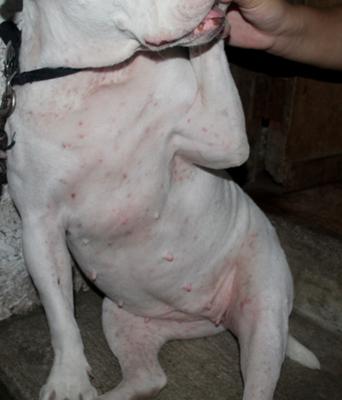American Bulldog's Recurring Skin Disease
by Nikko
(Makati City, The Philippines)

Reader Question: What Is The Cause Of My Dog's Recurring Skin Disease?
Hi
I'm so stressed about my dog's skin condition...Her skin problem started last February of 2011. The first time I noticed it, I immediately send her to Veterinarian. Meanwhile, after giving of IV medications, oral antibiotics and steroids for a week.....after 2 to 3 weeks, skin problems arise again.
Then I'll send my dog to vet again and do same medications...then will subside for 2 to 3 weeks....then will get same scenario again....
My dog's skin problem looks like a small patches and some has blood insides and it will just popped out and there will be a small lesions, and there's a reddish happening as well
Am so really stressed out of my dog's condition... I do badly needed your help....please do help me... Your comments and advises will be highly appreciated.
Thanks a lot and best regards
Nikko
From Makati, Philippines
Vet Suggestions For Possible Causes of Canine Recurring Skin Disease
Hi Nikko,
It sounds as if the veterinary care that your dog has received to this point improves her skin temporarily, but has not addressed the underlying cause for her condition. Two possibilities come to mind.
First, your dog might have allergic skin disease that predisposes her to skin infections. The antibiotics clear up the infection and the steroids control the allergies, until she is taken off of them. Another possibility would be an autoimmune disease of some sort, which subsides with steroid therapy. Other possibilities exist too. Your veterinarian is in the
I’ll talk a bit about allergies since I think that is the most likely condition you are dealing with. Your dog could be allergic to the bites of external parasites like fleas, to an ingredient in her food, or to environmental allergens like pollen, mold, and dust mites. If she is not already on an effective flea preventative like those that contain fipronil, that’s a good place to start. Food allergies can be diagnosed by only feeding her a hypoallergenic diet (e.g. one made with protein sources she’s never been exposed to) for six to eight weeks. Diagnosing environmental allergies often requires intradermal skin testing, but many owners elect symptomatic treatment instead. This can involve the long-term use of corticosteroids (ideally at the lowest effective dose given every other day), cyclosporine, twice weekly baths, and/or topical products like Dermoscent or Duoxo Seborrhea Spot-On that enhance the skin’s ability to protect itself from allergic triggers.
As you can see, getting to the bottom of recurrent skin problems in dogs is not always a simple process. Make sure your veterinarian knows that you want to prevent these flare-ups, not just deal with them when they arise. If you are unhappy with the care your dog is receiving, consider getting a second opinion.
Best of luck,
Jennifer Coates, DVM
Join in and write your own page! It's easy to do. How? Simply click here to return to Skin.







